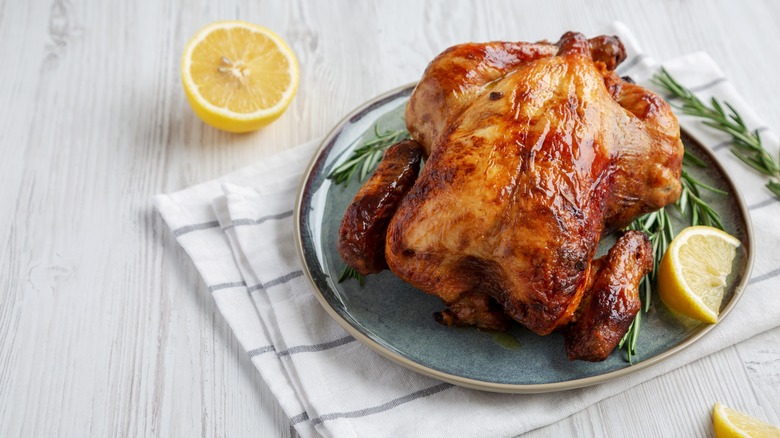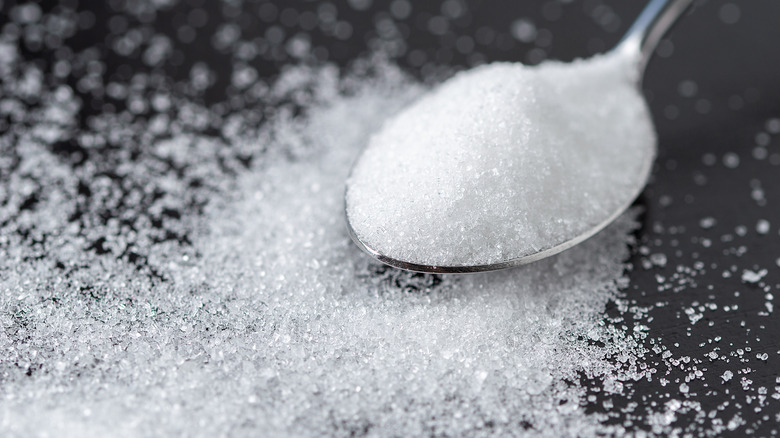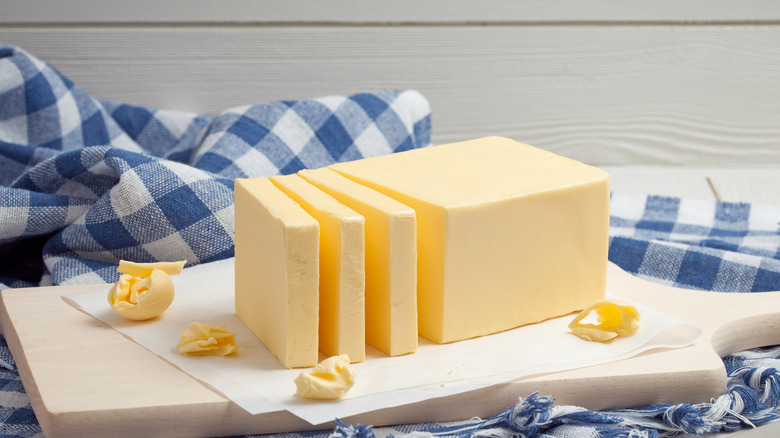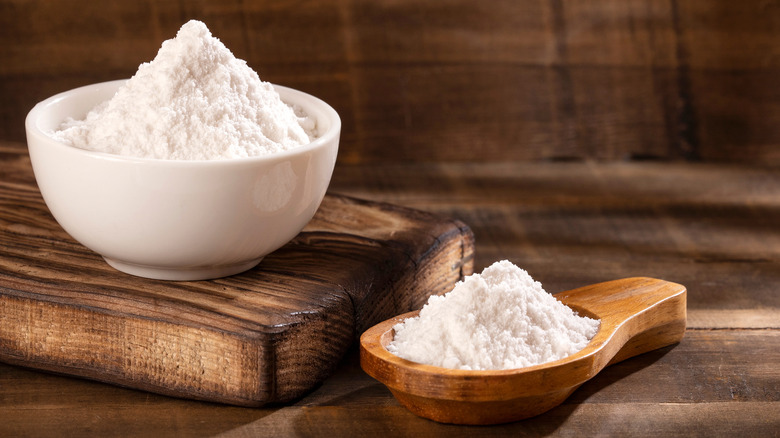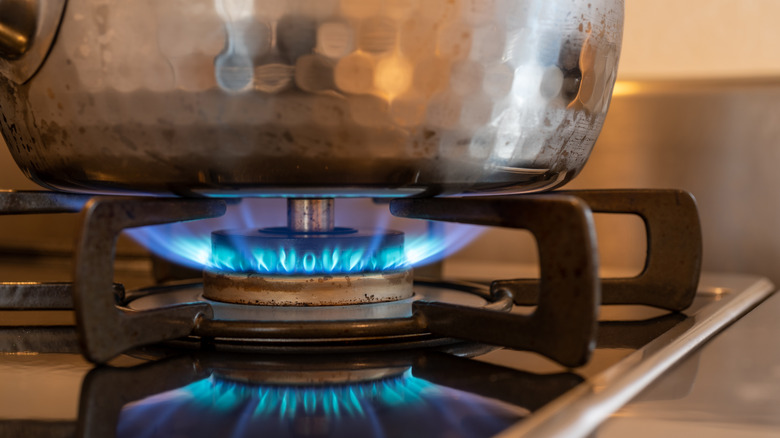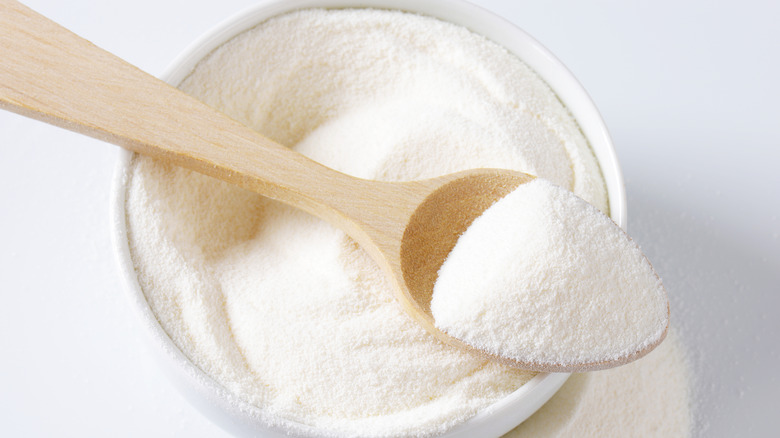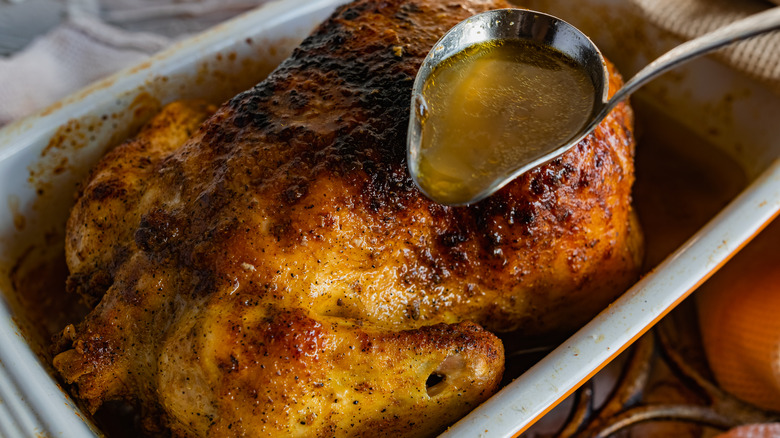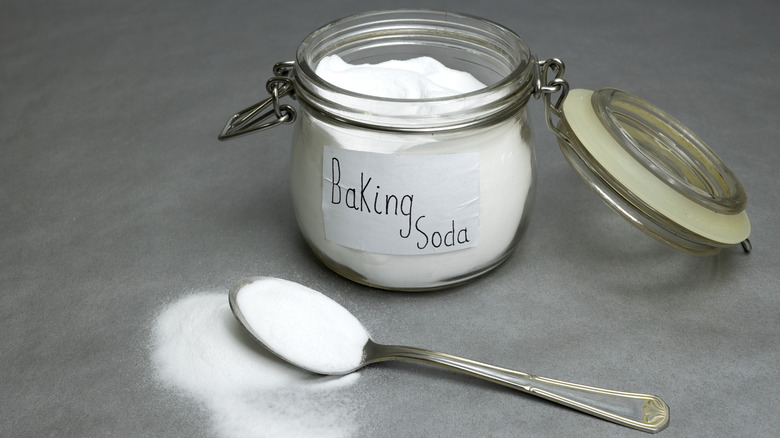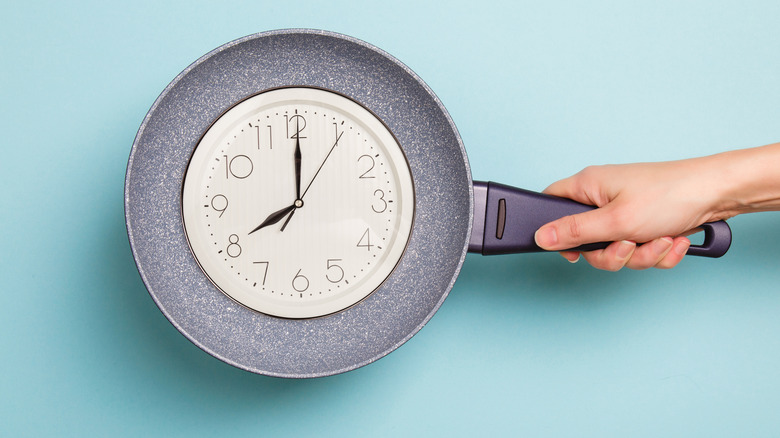10 Secret Ingredients That Will Help You Achieve Golden Brown Chicken
Chicken is a staple in most American homes. It's typically in the meal rotation at least once a week. But not all chicken is created equally. And nothing is worse than having chicken that turns out pale, beige, and tasteless. According to Wondrium Daily, cooking chicken properly is deceptively difficult. But there are many ways to get delicious golden brown chicken, just like in all those recipes online and on TV.
Roasting and frying in a skillet are the most common options if you aren't going to deep fry your chicken, which many people avoid because of the extra calories and fat. When preparing to make chicken that you want to turn out golden brown, the dryness of the bird and what you're cooking your chicken in matter. What you put on your bird is important, too. You can use dry brines and other treatments before cooking your chicken to get the golden brown skin or coating you're likely looking for. This method will work whether you cook chicken with the skin on or use boneless, skinless chicken breasts.
Some of the following tips may seem contradictory. For example, roasting uses low heat to create crispy, golden brown chicken, while skillet cooking requires high heat. And what you cook in makes a difference, too, at least if you're cooking on the stove. No matter how you cook your chicken, there are some things you should know and ways to prepare it if you want your chicken to turn golden brown.
Caramelize it with sugar or other sweeteners
There's a reason most brines and rubs contain sugar. The Healthy Journal explains that sugar helps to enhance the flavor of the meat you're cooking and any other spices you may have included in your rub or brine. Unlike salt, another common ingredient in brines and rubs, sugar barely absorbs into your meat. Instead, it forms a coating that helps the meat caramelize over high heat. You should include oil and salt in your brine as well. But if you are on a low-sodium diet, you may want to wait, as salt is far more likely than sugar to diffuse into your chicken. If you don't include it in your marinade or brine, add salt just before cooking your chicken to avoid drawing out moisture and leaving the meat dry.
And sugar isn't your only option to sweeten your meat and make it golden. Consider honey, hoisin, soy sauce, or more modern alternatives, like agave. The benefit of these other options is adding additional flavors to your chicken. Options like orange blossom or lavender honey can contribute their flavors to your meal, and soy sauce or hoisin will add sweet and salty flavors to your chicken. If you're using one of the latter, you may want to cut back on any salt you're adding separately. You also want to be careful not to add too much sugar or other sweeteners to your chicken. This could leave your meat charred instead of gorgeously golden.
Butter is better
Butter is an excellent way to brown your chicken breasts and a reasonably easy technique to use. Cook your chicken the way you usually would. Then, add butter to the skillet at just under 10 minutes, according to Fountain Avenue Kitchen. This will add flavor and help brown your chicken.
Using oil and butter together to sear your chicken breasts will create a golden brown crust on the exterior of your meat while also imparting flavor (via Tasting Table). But you don't have to sear your chicken with oil and butter to create a beautifully golden brown chicken. You can also use this technique with baked chicken.
If you are baking your bird, use plain, unsalted butter, or mix herbs into it, and rub a tablespoon of the butter mix under the skin of the chicken breast. This keeps the meat tender while it is cooking. Baste the outside of the chicken with the remaining butter, which master chef Julia Child says will give your chicken a golden brown skin (per Tasting Table). Start at 425 degrees for 15 minutes, then cook at 350 degrees for about an hour. Using oil and butter also helps keep your chicken from charring because liquid oils have a higher smoke point than butter (via Tasting Table). This way, you get the flavor from the butter and a golden crust without charring your meat or overcooking and drying it out.
Use oil or cooking spray
Oils are one of the easiest ways to get golden-brown chicken. Your go-to might be olive oil, but Home Cook World explains that it may not be the best option because of its low smoke point. Avocado oil and canola oil work better with the high heat required for browning your chicken. Let the chicken brown on each side for two to three minutes, avoiding the urge to press down on the chicken while it's cooking. This can release juices that will leave your meat dried out. Also, avoid checking or flipping the chicken while it's cooking. This could stunt the browning process.
Cooking spray works equally well with less mess (via The Washington Post). In a test by writer Becky Krystal, the cooking spray was as effective as oil when browning foods. She used olive oil and cooking spray on eggplant and received identical results in terms of cooking and browning. The benefits of using cooking spray are easier cleanup after the fact and more control when applying.
Wondering how to use cooking spray instead of oil? If you're roasting your chicken, you'll want to spray a cooling or baking rack and place the chicken on top. You'll also want to coat the chicken with cooking spray before it goes into the oven. This will give you crispy skin and a golden crust.
Coat it with baking powder
To brown your chicken and give it crispy skin, consider baking powder. You'll use it as a coating, mixing one part baking soda with three to four parts salt plus some pepper to taste, according to Mashed. Then lightly dust your chicken with the mixture before baking it.
There are a couple of reasons this works. The first is that it changes the pH level of the chicken. Baking powder helps break down the meat's proteins, making it easier to brown and get crispier. The second is that it forms carbon dioxide bubbles when it combines with the juices from the chicken. The chicken's increased surface area helps it bake up crispier and turn out golden brown. It's also essential that you let your chicken rest after dusting it with the baking powder mix. If you're roasting a whole chicken, you'll want to give it 12 to 24 hours in the refrigerator. You can let smaller pieces rest for as few as eight hours, but the longer you leave it sitting, the better.
There are a few things to remember if you use this treatment on your chicken. If you notice an unpleasant taste to your chicken after using the baking powder mix, you may be sensitive to sodium aluminum sulfate (via The Cookful). This substance is common in many store brands of baking powder, but aluminum-free brands are available.
Heat it up
This may seem obvious, but searing is one of the simplest ways to get beautiful golden brown skin on your chicken. And to sear, you need to use high heat. The art of this technique is in its brevity, according to Smart Chicken. High heat for a short time will make your chicken golden brown and crispy. This technique also works best with smaller cuts of meat like wings, thighs, and breasts.
Searing has additional benefits besides turning your chicken golden brown. It locks in moisture (via Laura Fuentes). This is especially important if you plan to finish cooking your chicken in the oven. In addition to giving you that golden brown color you're looking for, searing will also create a crust on the outside of your chicken that keeps the exterior from drying out while the interior of your chicken finishes cooking. You can use a splatter screen to keep messes under control if you like, but don't cover your skillet if you're planning to sear your chicken. If you do use a lid, you'll end up steaming your chicken instead of searing it.
Figuring out the perfect temperature can be a bit tricky, though. It turns out the medium setting on your stovetop is roughly 375 degrees, which is the ideal temperature for searing chicken. This will cook your chicken thoroughly inside while still producing that desirable golden brown exterior.
Try powdered milk
You may not realize it, but powdered milk is another way to ensure your chicken turns out gorgeously golden brown. And you likely already have some on hand in your kitchen cabinets. Tasting Table recommends dusting your chicken with powdered milk and coating it with cooking spray before adding it to your preheated pan.
Why does this work? Because powdered milk contains protein and sugar. Each, when combined with heat, creates the Maillard reaction, a caramelization process that causes your meat to brown. Together, these ingredients do double duty, making your chicken especially golden. But the Maillard reaction does much more than give you a golden exterior. It also improves the flavor of your chicken (or any other meat you're cooking). It creates different flavors depending on your cooking process -– baking, grilling, broiling -– but it can make or break your meal (via Modernist Cuisine). It's also why things like chicken taste different when baked than when they're grilled.
Whether roasting or grilling, powdered milk can work wonders for your chicken. It could be a bit too sweet when used on other meats, but it pairs perfectly with chicken, giving you that gorgeous golden brown color and grill marks in as little as two minutes. Another benefit of powdered milk is that it helps to dry or gently dehydrate the meat. Doing so keeps your chicken from steaming when you want it to roast or sear.
Keep it moist with water
We just talked about how drying is good for your chicken. And we cautioned against having too much moisture in and around your meat. So, it may sound a bit contradictory to suggest adding water. But this is a step you'll want to take so that your chicken tastes as good as it looks. There are plenty of seasonings you could add to your chicken, but Baking Mischief recommends using just salt and pepper. If you're looking for something zestier, consider Italian seasoning, herbs de Provence, Za'atar, taco seasoning, or others.
You can use a skillet or a pot for this process, but you will need a lid. This is because you want to steam the chicken after it's been browned. You're achieving a couple of things here. First, you create a beautiful piece of meat with a crusty, golden exterior. It will impress family and friends alike. You are also inspiring the Maillard reaction and giving your food more flavor. But you don't want to do all that just to end up with a dried-out piece of meat.
What good is your chicken if it looks lovely on the plate but leaves your palate disappointed? Presentation matters, of course, but ultimately, we want our food to taste good. You'll still want to use oil in your skillet for the initial browning on each side. Then add water and cover the skillet. This allows the chicken to finish cooking by poaching and sealing in moisture.
Use baking soda
Like baking powder, baking soda changes your chicken's alkalinity, creating a crispy, golden brown skin. According to The Healthy Journal, the perfectly golden result works when baking or frying your chicken because it speeds up the browning process. This method works particularly well with fried foods. Carbon dioxide bubbles are formed in the batter, creating a crispy, fluffy coating.
If you're not frying your chicken, mix the baking soda with your other seasonings and coat your chicken with it before cooking. Doing so will help to thin the skin on your chicken, making it crispier and more golden brown (via Practical Cooks). Baking soda is more robust than baking powder, so you'll want to use less to avoid a metallic flavor in your finished chicken.
You'll also want to consider what else you are using in your chicken, especially if you plan to fry it. Are there other acidic ingredients in your batter? If so, then you're in the clear to use baking soda. If not, you might want to consider using baking powder instead. Baking soda will also make your chicken cook faster than baking powder, so keep an eye on it as it becomes extra crispy and brown.
Cook with cast iron or stainless steel
This isn't an ingredient so much as a cooking tip, but the type of pan you're using can significantly affect how well your chicken turns out. Cooking it in a cast-iron or stainless-steel skillet is crucial if you want chicken to turn perfectly golden brown — it's important enough that Mashed includes chicken on its list of foods you should only cook in cast iron. A primary reason for this is that cast-iron cookware can go directly from the stovetop into the oven. In fact, cast iron can safely handle upwards of 600 degrees Fahrenheit for hours without cracking or warping. That makes it perfect for searing, frying, baking, or broiling (via Cookware Need). Many crispy, golden brown chicken recipes start on the stove and finish in the oven, so having an oven-proof skillet is essential.
Even if you're frying, you should consider cooking in a cast-iron skillet. You could end up with crispier, more delicious chicken with a shallow fry in cast iron than a much messier deep-frying operation. If you're looking for inspiration, give these Garlic Butter Chicken Thighs a try (per Tasting Table). They cook in cast iron. Use this type of pan and add butter to create a golden, crispy skin on your chicken. Start on the stove and finish in the oven. Since chicken thighs are higher in fat content than leaner cuts like chicken breasts, you might never cook a crispier, more golden chicken.
Take the time
Like choosing the right cookware, taking your time when cooking is another tip that doesn't necessitate adding ingredients so much as appropriately using what you have on hand. No matter what you add to your chicken, giving it time before you cook makes a huge difference. Golden, crispy skin comes from a dry bird, which is best achieved by allowing it to sit before cooking. To help dry chicken out and make it extra crispy, Self recommends brining your chicken or using a dry rub or salt crust. This will dehydrate your bird, helping to cook it to crispy perfection.
Air-drying is also highly recommended if you have the time and patience and if it doesn't bother you to keep chicken uncovered in your fridge. Give it two days to air dry if you can. If the idea of uncovered chicken in your fridge makes your skin crawl, you're not alone. But germaphobes rejoice! You can still create crispy chicken by putting the meat in a clean garbage bag or plastic shopping bag (via Miller's Food Market). Tie the bag around the pan loosely enough that air can still circulate. This lets your chicken air out without contaminating your refrigerator's other contents.
And if you don't have the time (or patience) to wait 24 hours or longer, there is a higher-speed version of this technique. Dry your chicken as well as possible, then let it sit on the counter for half an hour before cooking.
